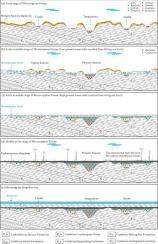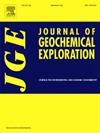Metallogenic model of the carboniferous karst bauxites in Central Guizhou Province, Southwest China
IF 3.4
2区 地球科学
Q1 GEOCHEMISTRY & GEOPHYSICS
引用次数: 0
Abstract
Karst bauxites, the dominant mineral resources of Guizhou Province, southwest China, are hosted in the Lower Carboniferous Jiujialu Formation and the Lower Permian Dazhuyuan Formation. Currently, the total bauxite resources in central Guizhou area (CGA) have exceeded 500 million tons. Herein, we present a detailed petrographic, mineralogical, and geochemical characterization of the Tanguanyao and Ganba bauxite deposits located in CGA, with a particular focus on the differences in mineral composition. The aim of this study is to discuss the genesis of major minerals, analyze the sedimentary environment of representative bauxite deposits, and further reveal the metallogenic model of the Jiujialu Formation. Mineralogically, the Tanguanyao bauxite is mainly composed of diaspore, chamosite, anatase, and pyrite, whereas the Ganba bauxite consists of diaspore, chamosite, anatase, boehmite, kaolinite, and illite. This is because the Tanguanyao and Ganba bauxite deposits are located in different paleo-elevation, and their mineral compositions are significantly different due to the fluctuation of groundwater level. Mineralogical evidence suggests that the diaspore in the Tanguanyao and Ganba bauxite deposits also includes supergene crystallization in addition to metamorphic processes. In terms of sedimentary environment, the Tanguanyao bauxite deposit belongs to the phreatic bauxite type characterized by a reducing environment, while the Ganba bauxite belongs to the transitional type between the vadose and phreatic facies.

中国西南贵州省中部石炭系岩溶铝土矿的成矿模式
岩溶铝土矿是中国西南部贵州省的主要矿产资源,赋存于下石炭统九家路地层和下二叠统大竹园地层中。目前,贵州中部地区铝土矿资源总量已超过 5 亿吨。在此,我们对位于黔中地区的唐古窑铝土矿和干坝铝土矿矿床进行了详细的岩石学、矿物学和地球化学特征描述,尤其关注了矿物成分的差异。本研究旨在探讨主要矿物的成因,分析具有代表性的铝土矿床的沉积环境,进一步揭示九家套地层的成矿模式。从矿物组成上看,唐古尧铝土矿主要由透辉石、闪长石、锐钛矿和黄铁矿组成,而甘坝铝土矿则由透辉石、闪长石、锐钛矿、波长石、高岭石和伊利石组成。这是因为唐古尧铝土矿和甘坝铝土矿矿床所处的古海拔高度不同,受地下水位波动的影响,其矿物组成也明显不同。矿物学证据表明,唐古尧铝土矿和甘坝铝土矿矿床的透辉作用除变质作用外,还包括超生结晶作用。在沉积环境方面,唐古尧铝土矿床属于以还原环境为特征的岩相铝土矿类型,而甘坝铝土矿则属于介于岩相和岩相之间的过渡型铝土矿类型。
本文章由计算机程序翻译,如有差异,请以英文原文为准。
求助全文
约1分钟内获得全文
求助全文
来源期刊

Journal of Geochemical Exploration
地学-地球化学与地球物理
CiteScore
7.40
自引率
7.70%
发文量
148
审稿时长
8.1 months
期刊介绍:
Journal of Geochemical Exploration is mostly dedicated to publication of original studies in exploration and environmental geochemistry and related topics.
Contributions considered of prevalent interest for the journal include researches based on the application of innovative methods to:
define the genesis and the evolution of mineral deposits including transfer of elements in large-scale mineralized areas.
analyze complex systems at the boundaries between bio-geochemistry, metal transport and mineral accumulation.
evaluate effects of historical mining activities on the surface environment.
trace pollutant sources and define their fate and transport models in the near-surface and surface environments involving solid, fluid and aerial matrices.
assess and quantify natural and technogenic radioactivity in the environment.
determine geochemical anomalies and set baseline reference values using compositional data analysis, multivariate statistics and geo-spatial analysis.
assess the impacts of anthropogenic contamination on ecosystems and human health at local and regional scale to prioritize and classify risks through deterministic and stochastic approaches.
Papers dedicated to the presentation of newly developed methods in analytical geochemistry to be applied in the field or in laboratory are also within the topics of interest for the journal.
 求助内容:
求助内容: 应助结果提醒方式:
应助结果提醒方式:


